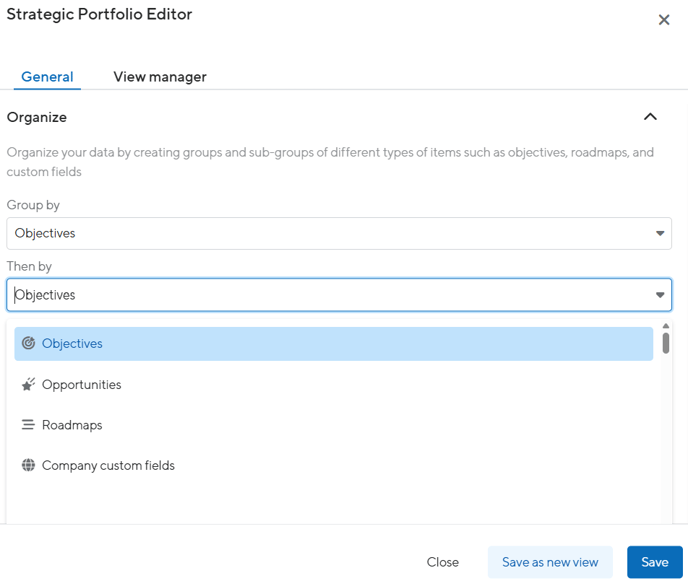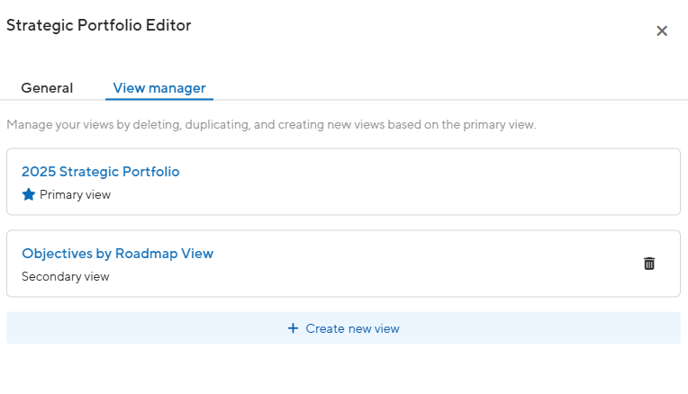Unlock flexible visualizations with Strategic Portfolio by customizing how data is grouped and presented.
Pivoting Your Strategic Portfolio
Creating and Managing Strategic Portfolio Views
Pivoting Your Strategic Portfolio
Strategic Portfolios can be customized to dynamically group your roadmap data by objectives, roadmaps, lanes, child objectives, custom dropdown fields (single or multi-select), or shared legends. Flexible grouping allows you to modify the groupings for both the primary and secondary lanes of your Strategic Portfolio, empowering you to organize your data in a meaningful way to quickly understand how teams and roadmaps are driving company goals.
- After saving a Strategic Portfolio, click Edit to open the Portfolio Editor.
- Under Organize, choose:
- Group by: Objectives, Roadmaps, Custom Dropdown Fields (single or multi), Shared Legends (Then by options will change based on the primary selection)
- Then by:
- For Objectives as Primary: Opportunities, Roadmaps, Custom Dropdown Fields (Single, Multi-Select), Shared Legends, or Child Objectives
- Note: The data set only includes bars and containers that are directly or indirectly (via an Initiative) related to the objectives selected to create the Strategic Portfolio.
- For Roadmaps as Primary: Lanes, Custom Fields (Single, Multi-Select), or Shared Legends
- For Custom Dropdown Field or Shared Legend as Primary: Custom Dropdown Field or Shared Legend
- Note: The same custom field cannot be used twice in the same view. Bars and containers that do not have any of the select custom field values will be displayed in a primary or secondary lane titled "Unlabeled work."
- For Objectives as Primary: Opportunities, Roadmaps, Custom Dropdown Fields (Single, Multi-Select), Shared Legends, or Child Objectives
- Note: Only available data will show based on what's in your portfolio set.
- Click Save to update the primary view, or click Save as new view to create a new view of this Strategic Portfolio.

Creating and Managing Strategic Portfolio Views
Strategic Portfolio Views allow you to create and save multiple visualizations of the same data without having to create a new portfolio.
- Click the Views dropdown next to the Strategic Portfolio title to toggle between views or create a new one.
- Click Create New View to generate a new view, then select different group by/then by settings if desired.
- Title your new view and click Save.
- Views will be accessible via the dropdown menu (the "primary view" is labeled).
- Open the Edit modal and go to the View Manager to delete any secondary views.
- Note: Primary views cannot be deleted.

Best Practices
- Create an outcome-driven portfolio
- For the primary view, use objectives as the primary "group by" to showcase how the work being done is driving impact and progression of company goals.
- Secondary views can be created to help tailor the visualization to specific audiences.
- Use clear view titles
- Title each view descriptively so users easily understand at a glance what each view represents.
- Use legends & custom fields consistently
- Ensure that your valuable custom fields and legends are applied to your roadmaps so that the view reflects this data.
- Ensure custom fields represent valuable data points
- Consider which fields are most valuable for various audiences and encourage teams to populate the fields that matter most within their individual roadmaps.
- Clean up missing metadata
- Use the "Unlabeled work" lanes to identify which bars or containers do not have the custom field values needed for your visualization, and encourage teams to review and address these gaps.
FAQ
Is this available on all plans?
This will only be available on Enterprise plans.
Will items show up under multiple lanes if they meet multiple groupings?
Yes. For example, if using a multi-select field, a single item can appear in multiple lanes.
Will users see items they don’t have permissions to?
Users can see visual representations of the items (title, grouping) but cannot open restricted underlying data.
What happens if there’s no data for a grouping?
If there’s no data for a selected grouping, you will see an error message prompting you to adjust your grouping selections.
What custom field types are supported for grouping?
Single-select dropdown fields, multi-select dropdown fields, and shared legends are supported for grouping.
What happens if a bar/container doesn't have a value for the custom field selected for grouping?
The item will appear in a lane or sub-lane titled "Unlabeled work."
